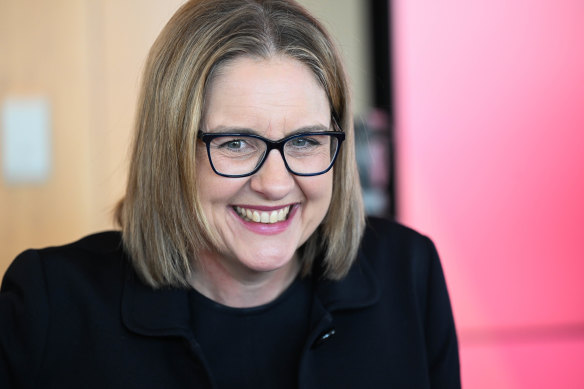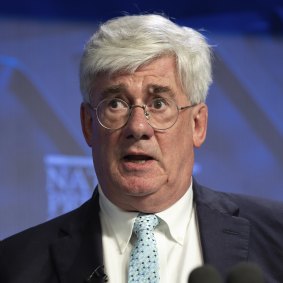- Exclusive
- Politics
- Victoria
- Victorian budget
Labor’s secret $75.7b war chest raises budget transparency fears
By Josh Gordon
An extraordinary $75.7 billion war chest has been squirrelled away by Labor in the state budget for as-yet-unannounced spending decisions as it gears up to fight the 2026 election.
The money, hidden by the Allan government in “hollow logs” in this month’s state budget papers, includes $38.5 billion for future recurrent promises over the next four years, and $37.2 billion worth of infrastructure asset decisions.

Premier Jacinta Allan will have billions of dollars for announcements in the 2026 election.Credit: Joe Armao
Analysis by The Age shows the vast bulk of the cash – about 91 per cent, or $69.3 billion – has been earmarked for decisions already made but not announced, with the remaining $6.4 billion set aside for future promises but “not allocated to a specific purpose”.
The figures include cash for as-yet-unannounced future spending promises, as well as for policy decisions and infrastructure projects that have been publicly flagged but have not yet had spending allocated to specific years or departments.
The growing use of budget “hollow logs” has raised questions among experts about what they see as a growing lack of transparency in the yearly financial figures and the allocation of money to unannounced projects when Victoria is in deficit.
Despite a recent GST windfall from the Commonwealth for Victoria, the budget predicted a deficit of $2.2 billion in 2024-25, more than double the $1 billion deficit forecast by state Treasury just six months earlier.
Treasury also predicted net debt will rise from about 22.3 per cent of the state economy currently to 25.2 per cent by the middle of 2027, before finally edging back by the barest of margins to 25.1 by the middle of 2028.
But the papers also reveal $12.2 billion has been set aside for unannounced policy decisions over the next financial year alone – an amount that could have easily covered the cost of bringing the budget back into balance, with plenty of change left over.
That figure comprises $5.4 billion for ongoing spending promises and $6.8 billion for infrastructure spending shielded from public scrutiny.
The figures show the amount being set aside for secret future policy decisions increases in each of the next four years, rising from $19.5 billion in 2025-26 to $21.4 billion in 2026-27, and then to an unprecedented $22.6 billion in 2027-28 – the first full financial year immediately after the November 2026 state election.
The growing use of unallocated spending represents a relatively new approach for the state government.
The amount of money set aside for unannounced policies leapt dramatically during the pandemic and has stayed high since.
In the previous budget, delivered in May last year, the government allocated almost $82 billion over four years. Some of these amounts were revised down in the current budget, largely because the government slowed the rate of contingencies for infrastructure spending.
In the 2016-17 budget – representing the same point in Victoria’s four-year political cycle as the state is in now – the government allocated just $2.8 billion for unannounced spending and asset decisions or $22.7 billion over four years.
The latest figures are likely to include an unknown amount secretly put aside for the state government’s flagship Suburban Rail Loop. The government has refused to provide details about when or how much funding for the massive project has been allocated, citing commercial considerations.
The first stage of the project, running from Cheltenham to Box Hill, was previously priced at between $30 billion and $34.5 billion, although construction costs have since risen sharply.
The budget papers also revealed $12.1 billion has been set aside for the so-called “advance to the treasurer”. According to a November 2020 report by the Victorian auditor-general, the treasurer’s advance is supposed to give the government the legal authority to access funds to meet “urgent expenditure claims”, without the need for parliamentary approval.
In reality, however, the advance has more recently been used to pay for non-urgent policy promises.
For example, a recent financial report published by Treasury reveals that in 2023-24, the advance was used to help pay for the government’s $250 power savings bonus, part of its free kindergarten announcement, and the mobile black spot program, among a vast range of other initiatives.

Government staff with the 2024-25 state budget papers this month.Credit: Joe Armao
RMIT Emeritus Professor David Hayward, who has analysed the budget figures, said the use of unannounced infrastructure and policy spending had become a major feature of the budget during the pandemic, providing an important buffer during the period of uncertainty.
But he said the government had worryingly continued with the approach, which raised questions about the transparency of the budget process. The use of the treasurer’s advance represented another mechanism by which the government could be avoiding scrutiny, he said.
“There is an argument about setting aside money for contingencies as being prudent budget management,” Hayward said. “It is the scale post-pandemic that is the problem.”

Economist Saul Eslake.Credit: Alex Ellinghausen
“It means that we are now less sure about the government’s actual budget position. It just all looks very rubbery. Whereas previously you would have assumed it was all locked in and the figures meant something, you can’t assume that any more because there is so much contingency built into the budget.”
A spokesman for Treasurer Tim Pallas said contingencies in the Victorian budget for 2024-25 were lower than those in the previous three budgets.
“Governments routinely centrally hold funding in contingency, pending allocation to departments upon the achievement of program milestones – particularly for capital projects and major reforms,” he said.
“Funding is also held in contingency to provide for future demand growth in areas like school enrolment and hospitals.”
Independent economist Saul Eslake said it was not unreasonable for governments to make provisions in budgets for unforeseen events such as natural disasters, to build in a financial buffer, or potentially shield some spending because of security or commercial-in-confidence concerns.
“But beyond that, ‘decisions taken but not yet announced’ is a way for the government to have lots of things to announce at politically opportune times, without having to answer the question of how they are going to pay for it because it has already been provided in the budget,” Eslake said.
“They will be able to announce a lot of things during the countdown to the November 2026 election without having to announce a further deterioration in the budget position. Anything that is hidden in there is a transparency issue.”
Get the day’s breaking news, entertainment ideas and a long read to enjoy. Sign up to receive our Evening Edition newsletter here.